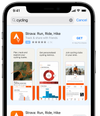This is part two of our short series of blogs, aimed at helping first-time and novice users of Apple Search Ads to get started with their App Store marketing.

If you read part one of this series, you will already have some knowledge about how to get started. So let's move on to targeting...
Thinking carefully about your target audience and the keywords with which they might search for your app, is an important step in planning your Apple Search Ads search results campaign. Within Apple Search Ads (or your chosen CMP), you have some audience targeting options at your disposal, which we touch on below, but more importantly, you have complete control over your target keywords. These are very powerful when it comes to ensuring that your ads are seen by the most relevant people.
Before we move on, it’s important to understand how Personalised Ads setting works on users’ iPhones and iPads and how this might influence your choices regarding audience settings in Apple Search Ads.
The Personalised Ads setting is either turned on, or off by the user. In Q1 2022, some 78% of App Store iOS 15 search volume came from devices with personalisation turned off. In short, this means that users’ known personal data (age, gender, app download history and purchase history) cannot be used to target your Apple Search Ads at them.
To overcome this, we recommend that you simply choose to display your ads to all eligible users and choose your keywords well, as they will do the targeting for you.
Choosing your target keywords

If you have taken the time to do your competitor research and write your metadata, you should have a good idea of what your target keywords and phrases should be. Ideally you want to have a good range of keywords that include both brand and competitor, and search terms that the user is likely to be using to find an app like yours.
Keywords will fall into Exact, Broad and Search match categories and your campaigns can be set up as such, to enable you to better manage your budget and keyword performance. Here is a short explanation of each category:
Exact match
Because you are targeting the exact search terms and their close variants (like common misspellings and plurals), that the user is searching with, the ad tap through rate (TTR) will be high – an example of an exact match keyword might be your brand name. It’s worth bearing in mind that exact match works very well for brands with high audience recognition (such as Nike or Netflix) as more people will immediately search for them by name; if your brand has low awareness, fewer people will search by name, so you may find that your impression rate is lower than desired.
Broad match
In this case, a user search term that is close in meaning to one of your keywords will produce a result. For example, if you have ‘fitness’ as a keyword, when an App Store visitor searches for ‘strength’ or ‘good health’, it will be a relevant match. You can expect a higher impression rate for broad match, but a lower relative TTR, since your app may not be exactly what they are looking for.
Search match
In a search match campaign you are allowing Apple Search Ads to assess the search terms that are being used in the App Store and decide if they are relevant to your app, based on your app’s metadata. For example, if a mobile game offers competitive puzzles, in addition to targeting generic terms such as ‘puzzle game’, Apple Search Ads may deem that the app is relevant to users searching ‘boost brain power’. Search Match is a good way to discover and review alternative keywords and search terms that you may not have thought of, but that App Store visitors are using (including competitor keywords. Bear in mind that you’ll likely experience higher impression rates, but lower TTRs overall, with a Search match campaign.)
Keep the door open to Discovery

You may feel that you already know your best keywords and you don’t want to expand on them; however, we recommend that you keep the door open to finding new keywords, which you can do by assigning a specific budget to a Search Match campaign. Astra, the Apple Search Ads campaign management platform by Redbox has a specific function that allows you to keep a ‘discovery’ campaign running.
Astra will look for relevant, undiscovered potential keywords and will also undertake ‘bid discovery’ for each keyword, to determine its budget efficiency. Once verified, Astra will start bidding on that keyword using its machine learning bid insights, which continually fine tune efficiency.
Targeting in words and pictures
When it comes to targeting, the old saying that a picture paints a thousand words, is true. You will have invested quite a bit of time in defining your audience and the most relevant target keywords for that audience – but don’t stop there!
For the best Apple Search Ads results, we suggest that you also tailor your ad creative and custom product pages to keywords and audiences. This is a better way to turn the heads of different audience cohorts than implementing narrower targeting parameters in your CMP dashboard.

Our creative team at Redbox have a great deal of experience with designing, auditing and testing custom product pages; in 2022 we noted that campaigns with custom product pages could expect to increase tap-thru-rate by up to 30% whilst also reducing cost-per-install by up to 40%.
So if you have a product offering that’s relevant to both men and women, create male and female versions of your product page. If you’re a fitness app that tracks running, cycling, and swimming – develop creatives for ads and product pages that are sport-specific and perfectly aligned with the search terms and keywords that the user will input.
Regional Targeting
Apple Search Ads allows you to set specific regional targeting for your campaign in all the storefronts in which your app is live. So, if you want a narrower regional target than the whole of the USA, for example, you can target specific States; or, rather than France, you can target Paris. Sometimes regional targeting is necessary for legal reasons: in the USA mobile sports betting regulations are different state-by-state, so it’s necessary to ensure that you are targeting appropriately located users.
Regional targeting potentially excludes people who may be interested in your topical app, but who don’t reside in the topical area. Be careful not to accidentally exclude potential users - narrowing your audience targeting parameters to very specific areas will also shrink the potential audience universe for your campaign, so when considering your targeting, it may be better to focus on specific and relevant keywords.
Let's wrap it up there
Perhaps the single most important point to take away from this is that carefully choosing keywords that best represent your well-defined audiences and well-defined offering, is the most efficient way to ensure your App Store campaigns are shown to the most relevant people. And lastly, to really empower user conversion, utilise custom product pages for a highly tailored customer journey from search to download.
For a best practice consultation for your App Store marketing, contact Redbox today.
